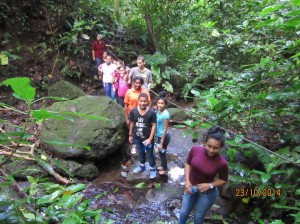Engaged Anthropology Grant: Margaret Crofoot and “Exploring the Jungle in the Backyard”

Margaret Crofoot is Assistant Professor of Anthropology at the University of California at Davis. In 2010, while at the Smithsonian Tropical Research Institute, she received a Post-Ph.D. Research Grant to aid research on ‘Do Capuchins Punish Cheaters? Cooperation, Coalitions, and Social Sanctions in Cebus capucinus Intergroup Aggression’. In 2013, she received the Engaged Anthropology Grant, which allowed her to return to her fieldsite and lead field trips bringing children from surrounding communities to observe researchers about their work.
Keeping one eye on the capuchins while listening to the excited voices coming slowly towards me up the trail, I always have a moment of anticipation: will they notice the monkeys over their heads, or will I get to point them out? One of the best parts of studying primate behavior at an easily accessible field-site like the one the Smithsonian Tropical Research Institute runs on Barro Colorado Island in Panama is getting to introduce visitors to my study subjects and share my discoveries with them. Monkeys overcome even the most extreme teenage nonchalance, and capuchins are particularly mischievous and engaging.
I’ve been doing research in Panama for more than ten years, and time and again, when people find out where I work—at dinner parties, in taxis, once in a hospital emergency room—I hear stories about the school trip they took to Barro Colorado Island (BCI), all the things they saw, and what an impression it left. The experience of exploring a tropical forest with scientists seems to resonate and have a large and lasting impact. This is why, when the Wenner-Gren Foundation announced their new Engaged Anthropology program, I saw an exciting opportunity to be able to sponsor field trips for schools that would otherwise be unable to afford to come to BCI.

In the last year, Oris Acevedo—BCI’s scientific coordinator—and I have worked together to bring over 200 elementary and high-school aged students to this international hotspot for tropical research to explore the jungle and learn about the science being done in their backyard. To reach the island, classes transit part of the Panama Canal. They are met by one of the Smithsonian’s scientist guides, who gives a short talk about the history of the research station, and about the animals and plants the students will see in the forest.
The group then heads into the forest to see what they can find. The Smithsonian’s guides are extremely knowledgeable about the plants and animals that live on BCI, and the research that has been done on them, so forest walks end up as part-scavenger hunt, part-impromptu mini lecture on whatever the group happens to encounter.

As part of their continuing education, the Smithsonian guides run a monthly seminar series, and they invited me to give two lectures on the behavior and ecology of Panamanian primates, highlighting my work on cooperation in capuchins which the Wenner-Gren Foundation funded.
For me, one of the highlights of this project was hosting a class of students from the Centro Educativo Básico General Residencial Vista Alegre, taught by my former student-intern Nena Robles. Nena worked with me for a year on my Wenner-Gren funded study of group cooperation during territorial conflicts in capuchin monkeys, before going on to get her Masters at the University of Torino in Italy. Helping Nena to bring her students—the next generation of Panamanian scientists—out to the field station where she got her start with research was really the epitome of what I think this outreach project can achieve.